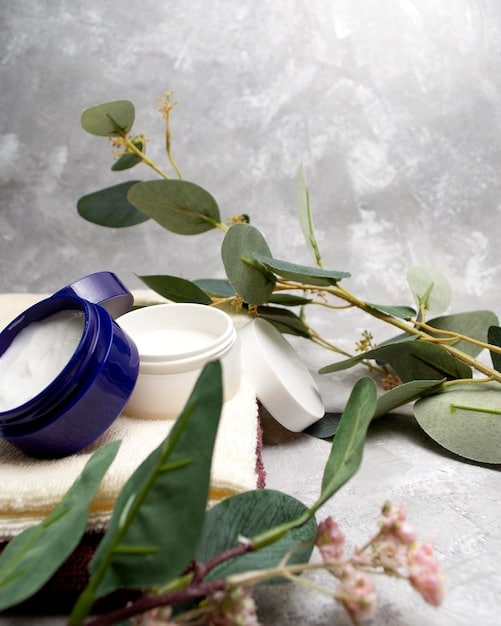Top 5 Skincare Ingredient Trends 2025: Worth the Hype?

Unveiling the Top 5 Skincare Ingredient Trends Dominating 2025: What’s Worth the Hype? reveals exciting new ingredients like postbiotics, advanced copper peptides, and sustainable botanicals set to revolutionize skincare routines, focusing on efficacy, skin health, and environmental responsibility.
Get ready to revamp your skincare routine! Unveiling the Top 5 Skincare Ingredient Trends Dominating 2025: What’s Worth the Hype? will guide you through the most innovative and effective ingredients poised to transform your skin.
The Rise of Probiotics and Postbiotics in Skincare
Probiotics have been a buzzword in gut health for years, but their skincare counterparts, particularly postbiotics, are gaining serious traction. These ingredients focus on supporting a healthy skin microbiome, crucial for overall skin health.
Understanding the Skin Microbiome
The skin microbiome is a complex ecosystem of bacteria, fungi, and viruses that live on our skin. Maintaining a balanced microbiome is essential for a healthy skin barrier, reduced inflammation, and protection against pathogens.
Benefits of Postbiotics in Skincare
Postbiotics are the metabolic byproducts of probiotics. They offer several advantages, including stability and the ability to directly nourish skin cells. They can help to:
- Reduce inflammation and redness.
- Strengthen the skin barrier function.
- Improve skin hydration.
- Balance the skin’s natural pH.

The appeal of postbiotics lies in their versatility and efficacy, making them a key ingredient to watch. As consumers become more educated about microbiome health, products containing postbiotics will continue to rise in popularity.
The Comeback of Copper Peptides: Advanced Formulations
Copper peptides aren’t new to the skincare scene, but advancements in formulation are bringing them back into the spotlight. These powerful peptides are known for their ability to stimulate collagen production and promote skin repair.
What Makes Copper Peptides Effective?
Copper peptides work by delivering copper, an essential trace element, to the skin. Copper plays a vital role in:
- Collagen and elastin synthesis.
- Wound healing and tissue repair.
- Antioxidant defense.
- Boosting hyaluronic acid production.
New Generation Copper Peptides
The latest copper peptide formulations leverage innovative delivery systems to enhance penetration and efficacy. These advancements minimize potential irritation and maximize the peptides’ benefits for:
- Reduced wrinkles and fine lines.
- Improved skin firmness and elasticity.
- Enhanced skin texture and tone.
- Faster skin recovery after procedures.
With improved formulations mitigating previous concerns of irritation, copper peptides are poised to become a staple in anti-aging regimens. Look for potent serums and creams boasting advanced copper peptide complexes for optimal results.
Sustainable and Ethical Sourcing: The New Standard
Consumers are increasingly aware of the impact their purchasing decisions have on the environment. This awareness is driving demand for skincare products that are sustainably and ethically sourced.
The Importance of Transparency
Brands are now expected to be transparent about their sourcing practices, providing information about where their ingredients come from and how they are processed. Terms like “organic,” “fair trade,” and “cruelty-free” are no longer just buzzwords – they are essential criteria for conscious consumers.
Ingredients to Watch: Sustainable Alternatives
Many brands are exploring sustainable alternatives to traditional skincare ingredients. Examples include:
- Upcycled ingredients: Repurposed byproducts from the food or agriculture industries.
- Plant-based stem cells: Extracted from plants using sustainable methods to provide potent antioxidants and anti-aging benefits.
- Marine actives: Derived from seaweed and algae, harvested responsibly to protect marine ecosystems.
Sustainable sourcing is not just a trend; it’s a necessary shift in the beauty industry. As consumers demand greater transparency, brands that prioritize ethical practices and environmental responsibility will be the winners.

Blue Light Protection: More Important Than Ever
In our increasingly digital world, exposure to blue light from screens is a constant concern. Prolonged exposure can lead to skin damage, including premature aging and hyperpigmentation. Blue light protection is becoming a crucial aspect of skincare.
The Effects of Blue Light on Skin
Blue light penetrates deeper into the skin than UV rays, potentially causing oxidative stress and inflammation. This can result in:
- Increased free radical damage.
- Breakdown of collagen and elastin.
- Dark spots and uneven skin tone.
- Accelerated aging process.
Ingredients that Offer Blue Light Protection
While traditional sunscreens are designed to protect against UV rays, they may not fully shield the skin from blue light. Ingredients that can help include:
- Antioxidants: Vitamin C, vitamin E, and ferulic acid can neutralize free radicals caused by blue light.
- Carotenoids: Lutein and zeaxanthin offer specific protection against blue light damage.
- Mineral sunscreens: Zinc oxide and titanium dioxide provide broad-spectrum protection, including some blue light coverage.
With our reliance on digital devices showing no signs of slowing, blue light protection will continue to be a key focus in skincare innovation. Protect your skin by incorporating antioxidant-rich products and mineral sunscreens into your daily routine.
Personalized Skincare Solutions: The Future is Custom
One-size-fits-all skincare is becoming a thing of the past. Consumers are seeking personalized solutions tailored to their unique skin needs and concerns. Technology is playing a key role in driving this trend.
The Rise of At-Home Diagnostics
Advancements in technology are enabling consumers to analyze their skin at home. Devices and apps can:
- Assess skin hydration levels.
- Measure sebum production.
- Identify fine lines and wrinkles.
- Detect underlying skin conditions.
Customized Formulations and Regimens
Based on the results of these diagnostic tools, brands can create customized skincare formulations with targeted ingredients. Personalized regimens take into account individual skin type, concerns, and lifestyle factors. This allows to have:
- Targeted treatment of specific skin issues.
- Improved product efficacy.
- Reduced risk of irritation.
- Enhanced overall skin health.
Personalized skincare is empowering consumers to take control of their skin health. As technology continues to evolve, expect to see more sophisticated diagnostic tools and customized product offerings.
These five skincare ingredient trends – postbiotics, advanced copper peptides, sustainable sourcing, blue light protection, and personalized solutions – represent the exciting future of the beauty industry. By staying informed about these innovations, you can make the best choices for your skin health and contribute to a more sustainable and effective skincare landscape.
| Key Trend | Brief Description |
|---|---|
| 🦠 Postbiotics | Metabolic byproducts of probiotics that balance the skin microbiome. |
| 🧪 Copper Peptides | Advanced formulas stimulate collagen and skin repair. |
| 🌱 Sustainable Sourcing | Ethical and eco-friendly ingredient sourcing. |
| 📱 Blue Light Protection | Ingredients that mitigate the damage from digital screens. |
Frequently Asked Questions
▼
Postbiotics are metabolic byproducts of probiotics. They help reduce inflammation, strengthen the skin barrier, improve hydration, and balance the skin’s pH levels, promoting a healthier complexion.
▼
Copper peptides stimulate collagen production, enhance wound healing, act as antioxidants, and boost hyaluronic acid, leading to reduced wrinkles, firmer skin, and improved texture and tone.
▼
Sustainable sourcing ensures ingredients are ethically and environmentally responsibly obtained. This supports eco-friendly practices and provides consumers with transparent, trustworthy products.
▼
Use antioxidant-rich products (like Vitamin C), carotenoids, and mineral sunscreens (Zinc and Titanium Dioxide). These ingredients help neutralize free radicals from blue light exposure.
▼
Personalized skincare addresses unique skin needs based on at-home diagnostics. This leads to targeted treatment, improved efficacy, reduced irritation, and enhanced overall skin health.
Conclusion
As we approach 2025, the skincare industry is set to be revolutionized by these innovative ingredients, driven by a consumer base that values efficacy, sustainability, and personalized care. Embracing these advancements will help you achieve optimal skin health while contributing to a more responsible beauty ecosystem.





